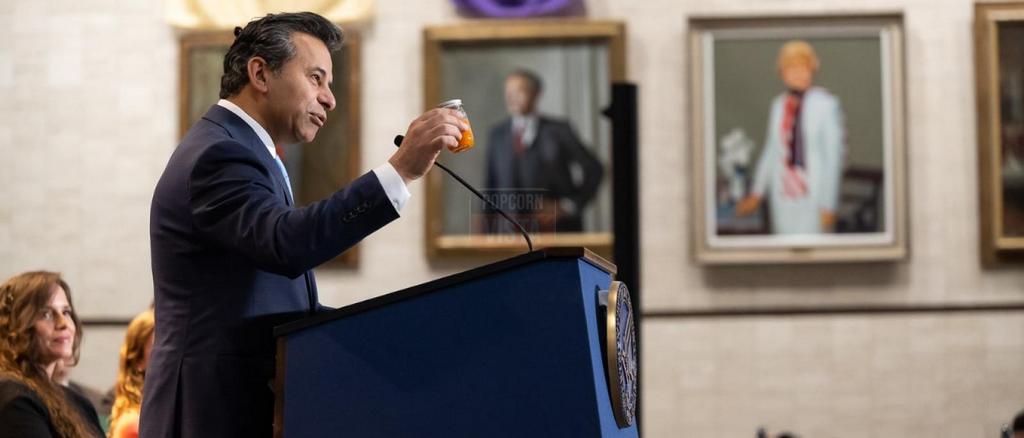On April 21, 2025, the U.S. Department of Health and Human Services (HHS) unveiled a groundbreaking initiative under the “Make America Healthy Again” (MAHA) campaign. Spearheaded by HHS Secretary Robert F. Kennedy Jr. and FDA Commissioner Marty Makary, the plan aims to ban petroleum-based synthetic food dyes from the nation’s food supply. Consequently, this move marks a significant step toward improving public health by addressing harmful chemicals in everyday foods. In this article, we’ll explore the details of this policy, its implications, and why it matters for American consumers.
What’s Behind the Ban?
The HHS decision targets artificial food dyes like Blue 1, Red 40, and Yellow 6, commonly found in candies, snacks, and beverages. These synthetic dyes, derived from petroleum, have raised concerns among health experts for years. Specifically, a 2021 California Office of Environmental Health Hazard report linked these dyes to behavioral issues in children, including hyperactivity and ADHD. Moreover, emerging research suggests potential risks like allergic reactions and long-term health effects.
Transitioning to safer alternatives, the HHS aims to eliminate these dyes entirely. For instance, natural colorants like beet juice or turmeric could replace synthetic options. As a result, this shift aligns with the broader MAHA goal of reducing chronic illnesses tied to processed foods. Additionally, Kennedy emphasized that this ban reflects a commitment to prioritizing consumer health over corporate profits.
Why Artificial Dyes Are Problematic
Artificial dyes serve primarily aesthetic purposes, enhancing the visual appeal of foods. However, their health impacts outweigh their benefits. Studies, including a 2015 meta-analysis in Pediatrics, found that children consuming these dyes showed increased hyperactivity. Furthermore, some dyes, like Red 3, have been flagged as potential carcinogens in animal studies. Despite this, the FDA has allowed their use, citing insufficient evidence of widespread harm.
On the other hand, critics of the dyes argue that the U.S. lags behind countries like the European Union, which already restricts several synthetic colorants. Therefore, the HHS ban signals a proactive approach to catching up with global health standards. By addressing these risks, the policy aims to protect vulnerable populations, particularly children.
How Will the Ban Be Implemented?
The HHS and FDA have outlined a phased approach to removing artificial dyes, with a joint announcement scheduled for April 22, 2025, to provide further details. Initially, the focus will be on enforcing compliance among food manufacturers. Surprisingly, major companies have shown minimal resistance during preliminary discussions, likely due to growing consumer demand for cleaner ingredients.
Moreover, the transition to natural alternatives will involve collaboration with the food industry to ensure affordability and availability. For example, companies like Mars and General Mills have already experimented with plant-based dyes in response to market trends. Nevertheless, challenges like higher production costs and supply chain adjustments may arise. To address these, the HHS plans to offer technical support and incentives for manufacturers.
State-Level Support and Momentum
Interestingly, several states have already taken steps toward similar bans. For instance, West Virginia introduced legislation in 2024 to restrict artificial dyes in school meals. Similarly, California’s Assembly Bill 2316, signed into law in 2024, bans six synthetic dyes in public schools. These state-level efforts reflect a growing public awareness of food safety, which the HHS ban builds upon.
As a result, the federal initiative is expected to streamline regulations nationwide, creating a unified standard. Additionally, this could inspire further reforms, such as restrictions on other artificial additives like preservatives or flavor enhancers.
Potential Benefits of the Ban Food Dyes
The removal of artificial dyes promises several advantages for public health and beyond. First and foremost, it could reduce behavioral issues in children, improving focus and academic performance. Furthermore, safer food options may lower the risk of allergies and chronic conditions linked to long-term dye consumption.
Beyond health, the ban could drive innovation in the food industry. By encouraging the use of natural ingredients, companies may develop healthier, more sustainable products. Consequently, this aligns with consumer preferences, as a 2023 Nielsen survey found that 68% of Americans prefer foods with natural ingredients.
Challenges and Criticisms
Despite its benefits, the ban faces potential hurdles. For one, critics argue that removing artificial dyes could increase food prices, as natural alternatives are often more expensive to produce. Additionally, some manufacturers may struggle to reformulate products without compromising taste or appearance. As a result, product availability could temporarily decrease, affecting consumer choice.
On the other hand, supporters counter that the long-term health savings outweigh short-term costs. For example, reducing diet-related illnesses could lower healthcare expenditures, which reached $4.5 trillion in the U.S. in 2022. Nevertheless, the HHS must balance these concerns to ensure a smooth transition.
What This Means for Consumers
For everyday Americans, the ban food dyes represents a shift toward safer, healthier food options. In particular, parents may feel reassured knowing that snacks and beverages are free from potentially harmful dyes. Moreover, the policy could spark broader conversations about food quality, encouraging consumers to scrutinize ingredient labels.
To prepare for the change, shoppers can start choosing products with natural colorants or whole foods like fruits and vegetables. Additionally, staying informed about the HHS’s progress will help consumers navigate the evolving food landscape.
Looking Ahead: The Future of MAHA
The artificial dye ban is just one part of the MAHA initiative’s broader mission to combat chronic disease. Under Kennedy’s leadership, the HHS is exploring other reforms, such as stricter regulations on ultra-processed foods and pesticides. Consequently, this could reshape the American diet, prioritizing nutrition over convenience.
Furthermore, the ban sets a precedent for evidence-based policymaking. By acting on scientific findings, the HHS demonstrates a commitment to public welfare. As more details emerge from the April 22 announcement, the nation will gain clarity on the timeline and scope of this transformative policy.
Conclusion
In summary, the HHS’s decision to ban artificial food dyes marks a pivotal moment in the “Make America Healthy Again” movement. By addressing the risks of synthetic colorants, the policy aims to protect public health, particularly for children. Although challenges like cost and reformulation exist, the benefits of safer, natural foods are undeniable. As the U.S. transitions to a cleaner food supply, consumers can look forward to a healthier future. Stay tuned for updates from the HHS and FDA as they roll out this ambitious plan.

